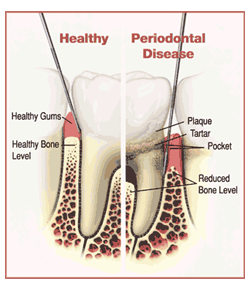
Gum Disease
What is Gum Disease?

Gum disease, or to use it's more correct term periodontal disease, is a serious infection that affects the tooth supporting tissues. It is believed to be caused by the presence of dental plaque, which results in inflammation of the gums (gingivae), and this inflammation in turn causes the underlying bone to dissolve, compromising the foundations and support for the tooth. It is a very common condition. It affects approximately 90% of the U.K. population. For most of those affected, the condition is not severe and it can be effectively treated by regular therapy from your own dentist or hygienist. For approximately 10-15% of sufferers the condition is far more serious, and specialist care is usually required, to prevent significant disfiguring gum recession, drifting and movement of teeth, or early multiple or complete tooth loss. There is also strong evidence to suggest that chronic untreated gum disease can increase the risk of other conditions such as heart disease and diabetes.
The exact cause of gum disease, and why it affects some individuals more than others, is not yet completely understood. It is an extremely complex disease process involving an interaction between plaque bacteria and the patients immune and inflammatory system. In effect there is a constant battle between the host's defence system and the plaque bacteria, and the collateral damage results in destruction of the local bone. Once the bone is destroyed, it pulls the gum down along the root of the tooth causing gum recession. This bone will never regenerate even when the disease is ultimately controlled, meaning that early intervention is critical.
*Image courtesy of American Academy of Periodontology
Signs and symptoms?
Unfortunately gum disease is a relatively silent condition. Many patients are completely unaware that they are suffering from the condition until their teeth become loose, by which time the prognosis for successful treatment is significantly reduced, or until the condition has been diagnosed by the dentist during routine examinations. Dentists can recognise the condition and its rate of progression from regular probing of the gum tissue and from regular dental radiographs.
Other signs of the presence of the disease are bleeding gums when brushing, increased redness of the gum tissue (they should be pale pink!), bad breath or a bad taste in the mouth. Patients need to be aware that absence of these symptoms does not mean absence of disease. Smoking is the biggest risk factor for the development of gum disease, but smoking also reduces the visible signs of inflammation. Therefore smokers often appear to have pink gum tissue without any evidence of bleeding on brushing, but severe bone destruction is likely to be occurring. It is important therefore to have a regular professional assessment of your gum health.
Who is at risk?
There is a significant probability that any one member of the population may be suffering from a severe form of gum disease. However, there are a number of risk factors which increase the likelihood that a severe form of gum disease will develop. The biggest risk by far factor is smoking. Other risk factors to be aware of are: stress, existing family history of gum disease (this may manifest as a family member wearing dentures) or a family history of diabetes.
Diabetes and gum disease have a close relationship. Diabetics have a higher risk of developing gum disease, and also, the presence of gum disease is thought to interfere with long term control of the diabetic condition. This would suggest that diabetics would benefit from treatment aimed at optimising their gum health.
Therefore, if there is a history of either gum disease or diabetes in a family, other family members should be regularly screened for the presence of gum disease.
Treatment
Happily, treatment of gum disease enjoys a very high success rate, even among patients who have had advanced destruction, and generally patients who have undergone treatment have found it very worthwhile. Treatment has the benefit of significantly increasing the chance of retaining the natural aesthetics and function of your teeth, as well as having a positive benefit to your overall health.
Treatment usually involves a phase of deep cleaning, also known as root planning, under local anaesthesia. This can take up to 4 long appointments. It also requires development of a new daily oral hygiene regimen which needs to be regularly assessed and modified. In some cases minor localised surgery will be required. Regular reviews are an essential part of initial therapy. Long term successful therapy requires regular hygienist therapy.
The cost of successful treatment is usually far less than the cost of replacing your teeth.
Essential Facts
- Bleeding gums is not normal
- Receeding gums and tooth loss is not a normal part of ageing. It usually indicates the presence of uncontrolled gum disease
- Gum disease has an effect on your overall health and can increase the risk of development of heart disease, diabetes and other conditions
- Gum disease does not mean that the sufferer is unhygienic, it just indicates that the patient is susceptible to the disease
- Gum disease is a “silent” disease and it may not be obvious to a patient that they suffer from this condition. Regular screening by a dentist is essential
- If there is a family history of gum disease, other members of the family should be screened to determine their periodontal status
- Gum disease is a major cause of tooth loss. In the USA twice as many teeth are lost due to gum disease compared to tooth decay
- Treatment of gum disease enjoys a very high success rate
- The cost of successful therapy is usually far less than the cost of replacing the diseased teeth
Gum Disease Animation
Please click the play button to watch a short animation on Gum Disease.